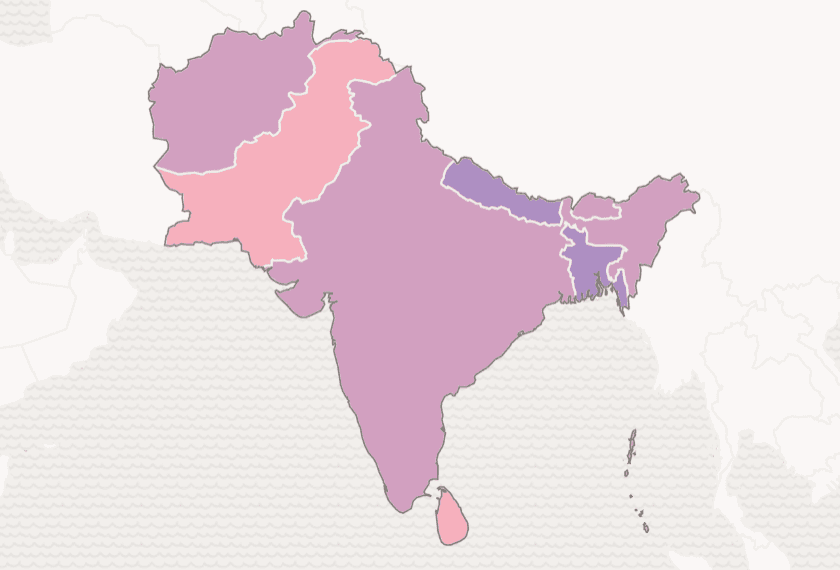Inequality in pre-primary attendance in West and Central Africa
Inequality in pre-primary attendance in West and Central Africa
The first few years of a child are crucial, building the foundations for learning and behaviour throughout life. During this critical period, early childhood education can shape the trajectories of children’s lives. It contributes to school readiness, prevents grade repetition, and strengthens school performance. Additionally, it brings long-term benefits to children, their families, and also to their economies. Evidence from studies by Noble Laureate James Heckman shows the high rate of return on investments in early childhood education by reducing intergenerational poverty, lowering social welfare costs, decreasing crime rates, and increasing tax revenue. Despite the advantages, half of all pre-primary school aged children are still out of school.
The Child Atlas brings together data on pre-primary attendance and allows us to perform cross-country comparisons of disaggregated trends by gender, residence and wealth. This data shows how children from the poorest and rural households are facing high inequalities in pre-primary education compared to those from the richest and urban households. The graphs below illustrate the same for percentage of children who attend organised learning programmes one year before the official primary entry age in Central African Republic (CAF), Liberia, and Sierra Leone. It is important to understand disaggregated trends in this data to uncover the stories behind the statistics and ensure policies and programs are inclusive and effective for all segments of the population. Looking at the graphs, we observe some intriguing trends.


What do the trends show?
The graphs show overall progress for all groups of children between 2006 and 2019 in all the three countries but sadly, progress has not been inclusive. The disaggregates show that in all three countries gender inequalities are the lowest, while the rural-urban divide is significant (figure 1), and wealth inequalities are the highest (figure 2). These factors are often intertwined. For instance, children from wealthier households often live in urban areas. Only 3% of all children in pre-primary schools are from the poorest families compared to about 50% of them being from the richest backgrounds. Moreover, in cities and towns about 1 in 4 schools are pre-primary while in more rural districts only 1 in 10 schools are pre-primary.
Zooming into Sierra Leone we see a V-shaped trend line for all groups from 2008 to 2013, but the trajectory of progress has slowed since 2013, more so for rural and poorer children. During this period, the gaps between the groups was the highest since 2008. These changes can possibly be explained by the Ebola virus epidemic of 2014-2016 which disproportionately affected marginalised children. Overall, we find that at lower rates of attendance, inequality was lower and started increasing with rising rates. This shows that higher rates of attendance are arising from more children of privileged households attending pre-primary programmes.
However, Sierra Leone had the most inclusive progress compared to CAF and Liberia. It is also the only country showing an increasing trend line for all groups of children. In contrast, the highest inequalities are found in CAF where there is no sign of convergence and rather, the most advantaged and most disadvantaged groups are diverging. The fact that pre-primary programmes in the three countries was not free could partly explain the differences in attendance rates by wealth quintiles. The trends point us to conduct further research on the three countries to find answers to questions we stumble upon during the analysis.
This data underscores the urgency to align policy and programmes to ensure that all children achieve SDG 4, especially those impacted by inequality and discrimination. Research shows that pre-primary education creates the highest rate of return on investment compared to other levels of education. Yet it receives even less than 1% of international aid to education and in low-income countries it receives less than 2% of the government’s education budget. The recent strides in policy, such as the 2018 Free Quality School Education Programme in Sierra Leone which aims to make equitable access to pre-primary education by making it free for all children, along with the 2021 National School Feeding Policy offer some hope for a more inclusive tomorrow. We must now wait for the updated data to see if progress in recent years is closing the gaps and charting the required trajectory.
Related stories:
Related stories

How a Soap Opera Helped to Reduce Child Marriage
Child protection (CP)
Child protection (CP)
2025-12-09

Does Insurance Benefit Child Health? Lessons from 38 Countries
Health (HL)
2025-11-19